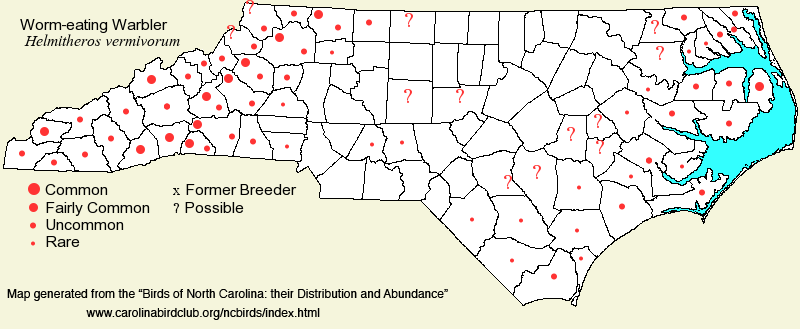 |  |
|
Worm-eating Warbler - Helmitheros vermivorum PARULIDAE Members: | Search Common: Search Scientific: |
|
|
|||||||
| General Comments | The Worm-eating Warbler is not one of better known warblers in North America. It is really not common anywhere, and its breeding range was not fully understood until a few decades ago. It was always known from the Central states and the Northeast, but its breeding range in the Coastal Plain of the Carolinas was not known until perhaps the 1960's. The species likely bred there all along, but it certainly expanded in habitats and numbers by utilizing the broadleaf (and mostly evergreen) understory that grew up beneath planted stands of Loblolly Pines, in former dense pocosins or nonriverine swamps and hardwoods. It does nest in "pristine" habitats of various bay forests, nonriverine wet hardwood forests, and taller pocosins (with a tree canopy). It avoids any and all riverine forests for breeding in the Coastal Plain. It is best known as a breeder in the state in the lower mountains and foothills, where it favors dense stands of Rosebay Rhododendron and/or Mountain Laurel, beneath a varied canopy, and almost always on moderate to steep slopes. In migration, it also likes dense cover in shrubs and understory beneath a forested canopy; however, these understory/shrub species can be deciduous. | ||||||
| Breeding Status | Breeder | ||||||
| NC BRC List | Definitive | ||||||
| State Status | |||||||
| U.S. Status | |||||||
| State Rank | S4B | ||||||
| Global Rank | G5 | ||||||
| Coastal Plain | Summer resident, and transient. In summer, uncommon to locally fairly common in the eastern 60% of the province (except absent on the immediate coast); occurs inland to Gates, eastern Edgecombe, southern Cumberland, and eastern Robeson. A confirmed nesting (adults feeding a young bird) was reported near Council (Bladen) on 30 Jun 2024. However, absent over large areas where suitable nonriverine forested habitats are lacking. Elsewhere, uncommon and easily overlooked migrant, but rare along the coast in migration. Mainly mid-Apr to late Sep. Remarkable, if correct, was one seen on the Wilmington CBC on 30 Dec 2006. Peak counts: | ||||||
| Piedmont | Summer resident, and transient. In summer, uncommon to locally fairly common in most foothill ranges, east to Stokes, Alexander, and Burke; also apparently rare and disjunct in the Uwharrie Mountains, east to Montgomery. A few scattered summer records in the "flatlands" of the central and eastern portions, but not consistent at any site. Otherwise, an uncommon and easily overlooked migrant, especially silent in fall. Mainly mid-Apr to late Sep. Two winter reports, both hopefully correct: 1, Charlotte, 16 Dec 1963, and one in Mecklenburg, 12 Jan 2024. Peak counts: | ||||||
| Mountains | Summer resident. Uncommon to often fairly common (and not obviously local) below about 3,500 feet; rare to uncommon to 4,000 feet. In the northern counties -- Alleghany, Ashe, Watauga, Avery, etc., it is limited mainly to the Blue Ridge Escarpment along their eastern borders; more widespread across counties farther southward. Migrants not obvious. Mainly mid- or late Apr to late Sep. Peak counts: | ||||||
| Finding Tips |
The species should be heard, and hopefully seen, by driving roads through Alligator River NWR, the best area in the Coastal Plain. Sites such as Chimney Rock Park (Forest Stroll Trail) and South Mountains SP are good spots in the foothills. *** | ||||||
| Attribution | LeGrand[2024-11-08], LeGrand[2024-05-14], LeGrand[2023-04-03] | ||||||
| NC Map Map depicts all counties with a report (transient or resident) for the species. | Click on county for list of all known species. |
| NC Breeding Season Map Map depicts assumed breeding season abundance for the species. |  |